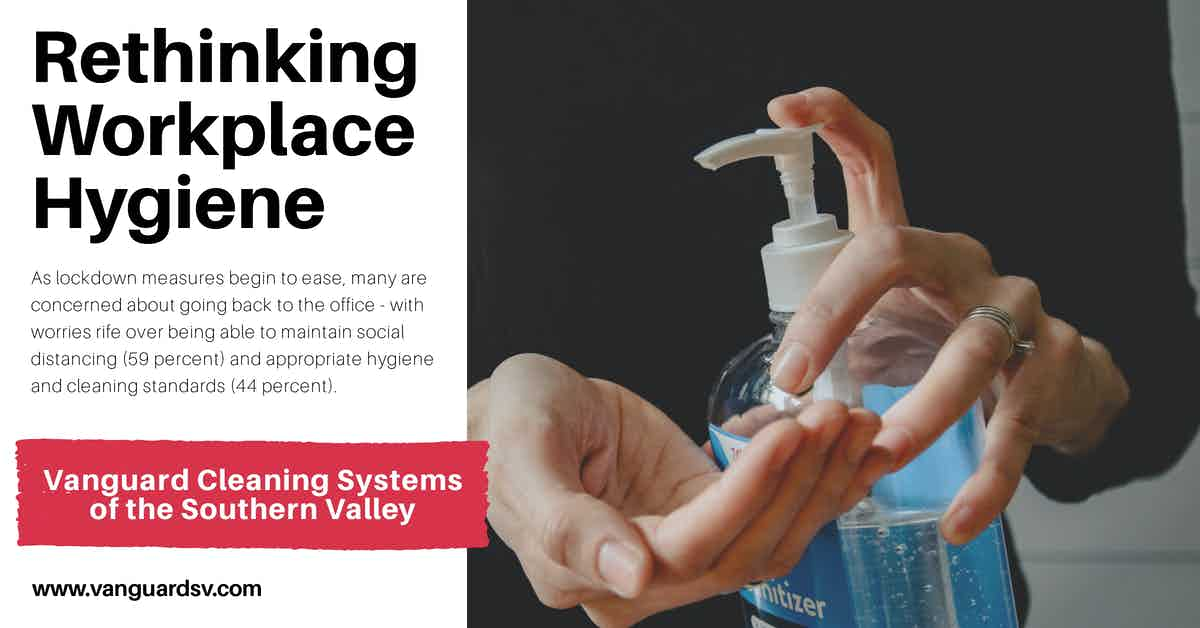The COVID-19 pandemic has forced facility managers, business owners, and school supervisors to rethink facility hygiene and reshape the way we approach surface sanitation, workplace wellness, and occupant health.

Workplace Safety and Hygiene Impact Worker Stress
Over the past year, stress has become a constant companion for many people, especially in the workplace where close quarters and high foot traffic collide with the constant fear of infection and concerns regarding facility sanitation.
The YouGov poll of 404 office staff members working from home, commissioned by IWFM, reveals that over a third (34 percent) are concerned about getting used to a corporate office culture again after the lockdown.
As lockdown measures begin to ease, many are concerned about going back to the office - with worries rife over being able to maintain social distancing (59 percent) and appropriate hygiene and cleaning standards (44 percent).
Hygiene Anxiety – 44 Percent Of Workers Are Worried About Office Cleanliness
This is compounded upon the already staggering number of people suffering from some form of diagnosed anxiety disorder--9%--and the number of people reporting ongoing stress or anxiety in their daily lives--40%.
The impact of workplace anxiety and high stress is observable, often arising in the form of:
- Decreased job performance and quality of work.
- Issues with concentration, fatigue, irritability, and reduced productivity.
- Turning down opportunities due to phobias.
- Reduced job satisfaction.
- Diminished confidence in skills.
- An observable reduction in goal setting and achievement.
- Feelings of isolation.
- Reduced social skills and ability to function within a team.
- Ineffective planning capacity, and;
- The avoidance of innovation.
Introducing better cleaning and facility hygiene practices can demonstrably contribute to a less stressful workplace, especially during the waning months of the pandemic when more and more people will be returning to the office.
Building a Better Workplace Through Improved Hygiene and Cleaning Standards
A critical component in building a better, healthier workplace is indoor air quality.
Current facility designs--until quite recently--ignored indoor air quality and pollution altogether in favor of energy conservation.
Prior to the pandemic, many facility managers and business owners were waking up to the necessity of increasing the flow of fresh, clean air through a building to maximize occupant health and wellness.
Now, under the weight of an airborne and deadly virus, indoor air quality, cleaning systems, and ventilation systems have become a focal point for organizations of every type and size.
Additional factors that have played key roles in maintaining the health and safety of front-line essential workers include:
- Day porter services to facilitate regular touchpoint disinfection and restroom checks.
- Safer Choice disinfectant products that are certified by both the U.S. Environmental Protection Agency as effective against SARS-CoV-2, Influenza, Norovirus, and other common pathogens, as well as the Environmental Working Group for containing active ingredients that are safer for humans, animals, and the environment, and;
- More efficient and effective cleaning and disinfection tools, such as electrostatic disinfection appliances, to rapidly sanitize regularly cleaned areas of a facility in less time, using fewer chemicals, and requiring a fraction of the cleaning staff.
One specific area of any facility that requires heightened attention--the reigning king of occupant complaints regarding hygiene and smells long before the pandemic--is restrooms.
High-quality hand hygiene is fundamental to disease transmission prevention all year long, and a clean, well-stocked restroom is one of the best ways to ensure occupant participation and compliance.
Improved hand hygiene via increased restroom sanitation will also reduce the germ load throughout a building--resulting in fewer illnesses and absences.
Recent research has shown that the best ways to improve occupant participation in organization-wide hand sanitation programs while significantly reducing stress levels are to:
- Provide paper towels over airblown hand dryers--a feature preferred by a reported 69% of Americans.
- Stock the restroom with high-quality paper products that have the qualities of strength, absorbency, and softness, and;
- Install touchless soap, water, and paper towel dispensers to reduce hand-to-surface contact.
References & Resources
Takeaway
Rethinking workplace hygiene and the role cleaning plays in reducing occupant stress will aid greatly in the coming months as students, teachers, and employees return to the classroom or office.
Improved cleaning that focuses on air quality, occupant wellness, efficient cleaning, and targeted disinfection threw back an airborne virus that stopped the world in its tracks.
Continuing and improving upon those methods will help workers de-stress in their return to the workplace and provide everyone with the peace of mind necessary to get their lives, education, and careers back on track.
Outsourcing is a proven method for ensuring the highest standards of cleanliness, safety, and training while controlling costs and eliminating management overhead.
If you would like more information regarding the effectiveness of high-performance infection prevention and control measures, or if you would like to schedule a free, no-obligation onsite assessment of your facility's custodial needs, contact us today for a free quote!
In Bakersfield, CA, call (661) 437-3253
In Fresno, CA, call (559) 206-1059
In Valencia CA, or Santa Clarita CA, call (661) 437-3253
In Palmdale, CA or Lancaster, CA, call (661) 371-4756

